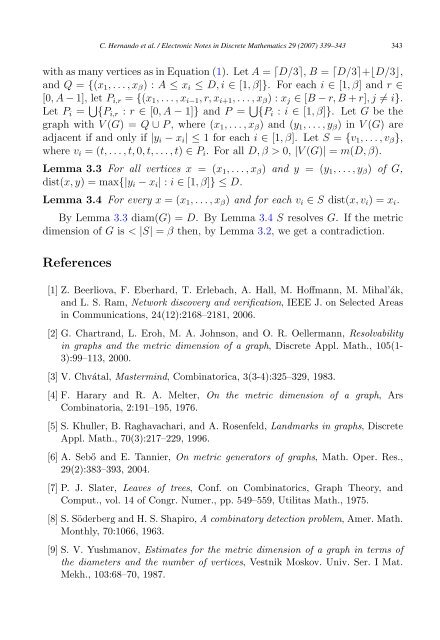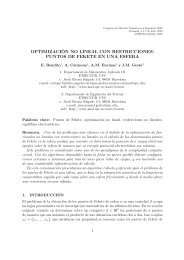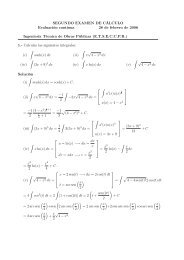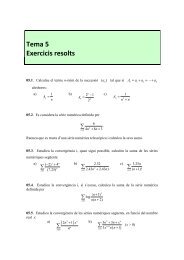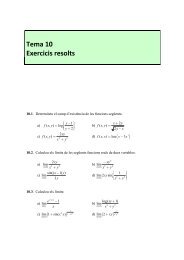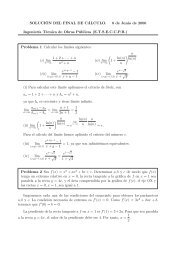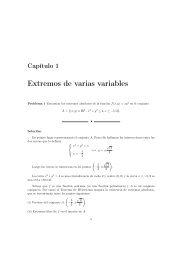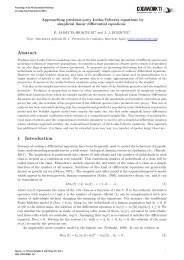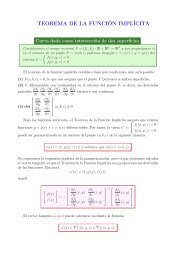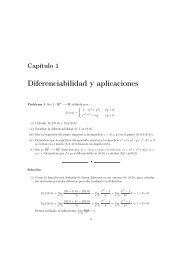Extremal Graph Theory for Metric Dimension and Diameter
Extremal Graph Theory for Metric Dimension and Diameter
Extremal Graph Theory for Metric Dimension and Diameter
Create successful ePaper yourself
Turn your PDF publications into a flip-book with our unique Google optimized e-Paper software.
C. Hern<strong>and</strong>o et al. / Electronic Notes in Discrete Mathematics 29 (2007) 339–343 343<br />
with as many vertices as in Equation (1). Let A = ⌈D/3⌉, B = ⌈D/3⌉+⌊D/3⌋,<br />
<strong>and</strong> Q = {(x 1 ,...,x β ):A ≤ x i ≤ D, i ∈ [1,β]}. For each i ∈ [1,β] <strong>and</strong> r ∈<br />
[0,A− 1], let P i,r = {(x 1 ,...,x i−1 ,r,x i+1 ,...,x β ):x j ∈ [B − r, B + r],j ≠ i}.<br />
Let P i = ⋃ {P i,r : r ∈ [0,A− 1]} <strong>and</strong> P = ⋃ {P i : i ∈ [1,β]}. Let G be the<br />
graph with V (G) =Q ∪ P , where (x 1 ,...,x β ) <strong>and</strong> (y 1 ,...,y β )inV (G) are<br />
adjacent if <strong>and</strong> only if |y i − x i |≤1 <strong>for</strong> each i ∈ [1,β]. Let S = {v 1 ,...,v β },<br />
where v i =(t,...,t,0,t,...,t) ∈ P i . For all D, β > 0, |V (G)| = m(D, β).<br />
Lemma 3.3 For all vertices x = (x 1 ,...,x β ) <strong>and</strong> y = (y 1 ,...,y β ) of G,<br />
dist(x, y) = max{|y i − x i | : i ∈ [1,β]} ≤D.<br />
Lemma 3.4 For every x =(x 1 ,...,x β ) <strong>and</strong> <strong>for</strong> each v i ∈ S dist(x, v i )=x i .<br />
By Lemma 3.3 diam(G) =D. By Lemma 3.4 S resolves G. If the metric<br />
dimension of G is < |S| = β then, by Lemma 3.2, we get a contradiction.<br />
References<br />
[1] Z. Beerliova, F. Eberhard, T. Erlebach, A. Hall, M. Hoffmann, M. Mihal’ák,<br />
<strong>and</strong> L. S. Ram, Network discovery <strong>and</strong> verification, IEEE J. on Selected Areas<br />
in Communications, 24(12):2168–2181, 2006.<br />
[2] G. Chartr<strong>and</strong>, L. Eroh, M. A. Johnson, <strong>and</strong> O. R. Oellermann, Resolvability<br />
in graphs <strong>and</strong> the metric dimension of a graph, Discrete Appl. Math., 105(1-<br />
3):99–113, 2000.<br />
[3] V. Chvátal, Mastermind, Combinatorica, 3(3-4):325–329, 1983.<br />
[4] F. Harary <strong>and</strong> R. A. Melter, On the metric dimension of a graph, Ars<br />
Combinatoria, 2:191–195, 1976.<br />
[5] S. Khuller, B. Raghavachari, <strong>and</strong> A. Rosenfeld, L<strong>and</strong>marks in graphs, Discrete<br />
Appl. Math., 70(3):217–229, 1996.<br />
[6] A. Sebő <strong>and</strong> E. Tannier, On metric generators of graphs, Math. Oper. Res.,<br />
29(2):383–393, 2004.<br />
[7] P. J. Slater, Leaves of trees, Conf. on Combinatorics, <strong>Graph</strong> <strong>Theory</strong>, <strong>and</strong><br />
Comput., vol. 14 of Congr. Numer., pp. 549–559, Utilitas Math., 1975.<br />
[8] S. Söderberg <strong>and</strong> H. S. Shapiro, A combinatory detection problem, Amer. Math.<br />
Monthly, 70:1066, 1963.<br />
[9] S. V. Yushmanov, Estimates <strong>for</strong> the metric dimension of a graph in terms of<br />
the diameters <strong>and</strong> the number of vertices, Vestnik Moskov. Univ. Ser. I Mat.<br />
Mekh., 103:68–70, 1987.


